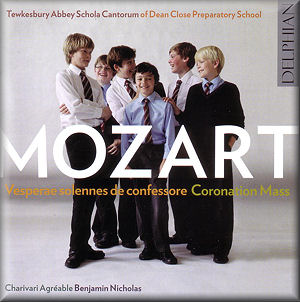 |
 |
|


alternatively
CD: MDT
AmazonUK
AmazonUS
Sound
Samples & Downloads |
Wolfgang Amadeus MOZART (1756-1791)
Mass in C, K 317, Coronation (1779) [24:48]
Ave verum corpus, K618 (1791) [3:12]
Vesperae solennes de Confessore, K339 (1780) [26:52]
 Laurence Kilsby (treble); Jeremy Kenyon (alto); Christopher Watson
(tenor); Christopher Borrett (bass)
Laurence Kilsby (treble); Jeremy Kenyon (alto); Christopher Watson
(tenor); Christopher Borrett (bass)
Tewkesbury Abbey Schola Cantorum of Dean Close Preparatory School
Charivari Agréable/Benjamin Nicholas
rec. 12-13 July 2011, Merton College Chapel, Oxford
Texts and translations included
 DELPHIAN DCD34102 [54:59]
DELPHIAN DCD34102 [54:59]
|
|
|
Thirty-two singers are listed in the booklet accompanying this
disc, of whom eighteen are trebles. They are pupils at Dean
Close Preparatory School in Cheltenham, and they join with the
adults to sing the weekday evensong services at Tewksbury Abbey.
Charivari Agréable are a period instrument group based in Oxford.
A little more than a year separates the composition of the two
principal works on this disc. Mozart’s early life is dominated
by travelling, but these works were composed during a two-year
period when the composer was in Salzburg in service to the Archbishop,
a situation he found increasingly frustrating. The short, celebrated
Ave verum corpus was composed in the very last year
of his life when he was visiting his wife and son who were staying
in the spa town of Baden.
The performance of the Mass is an exuberant one. The energy
level rarely dips in this work, and these performers respond
with enthusiasm. There seems no question that the young singers
are thoroughly enjoying themselves, but I think rather more
in the way of variety of dynamics should have been expected
of them. Mozart is either forte or piano,
but forte is at least that here, and often rather more,
whereas indications of piano are not always respected
to the letter. I felt this particularly at the opening of the
Sanctus, where the forthright attack is rather unwelcome after
the rather relentless Credo. It is all superbly sung, though,
and if you like your Mozart like this, and the idea of an all-male
choir appeals, there is certainly no reason to hesitate.
Careful control of pace and phrasing is necessary if Ave
verum corpus is not to become marmoreal. This performance
is again beautifully sung and manages to stay on the right side
of the line. I can’t in all honesty say the same about the famous
“Laudate Dominum” in the K339 Vespers, as the tempo is really
too slow and the phrasing rather too affectionate, with something
of a tendency to hold back at the ends of phrases. This is the
moment, however, to draw attention to the remarkable treble
soloist, Laurence Kilsby. He has a beautiful voice and his singing
is highly expressive and musical. One notes, too, especially
in the “Laudate Dominum”, his outstanding breath control. Something
of a pity, then, that he sings with quite a pronounced vibrato
when there is not of trace of this in the introductory violin
melody. The remaining, adult, soloists are very fine too, though
vibrato remains a problem, if only because of the discrepancy
in style between the vocal participants and the instrumental
ensemble. (I have no problem, personally, with vibrato in Mozart.)
Otherwise, the performance of the Vespers follows pretty much
the same pattern as that of the Mass, with both its strong points
and its weaker ones. There really is more light and shade in
Mozart’s choral writing than is in evidence here, and the effect
sometimes becomes tiring. The recording is very immediate and
vivid, with the quartet of soloists well forward, which rather
exacerbates this. But there are many wonderful moments. These
performers’ way with the word “saeculorum”, for example, just
before the final “Amens” of the second movement “Confitebor”,
is only one example of singing that it quite seductive and totally
convincing. Overall, though, the singing has a few rough edges
compared to that of the Mass, unsurprising as it is a more difficult
work.
Benjamin Nicholas is Director of Choral Music at Dean Close
Preparatory School, and keen-eyed readers will spot that he
is also jointly responsible, with Peter Phillips, for the outstandingly
fine choir at Merton College, Oxford, whose first recording,
entitled “In the Beginning”, was recently released, also on
Delphian. Charivari Agréable play splendidly, and seem at one
with the conductor’s view of the works.
William Hedley
see also review by John
Quinn
|
|

